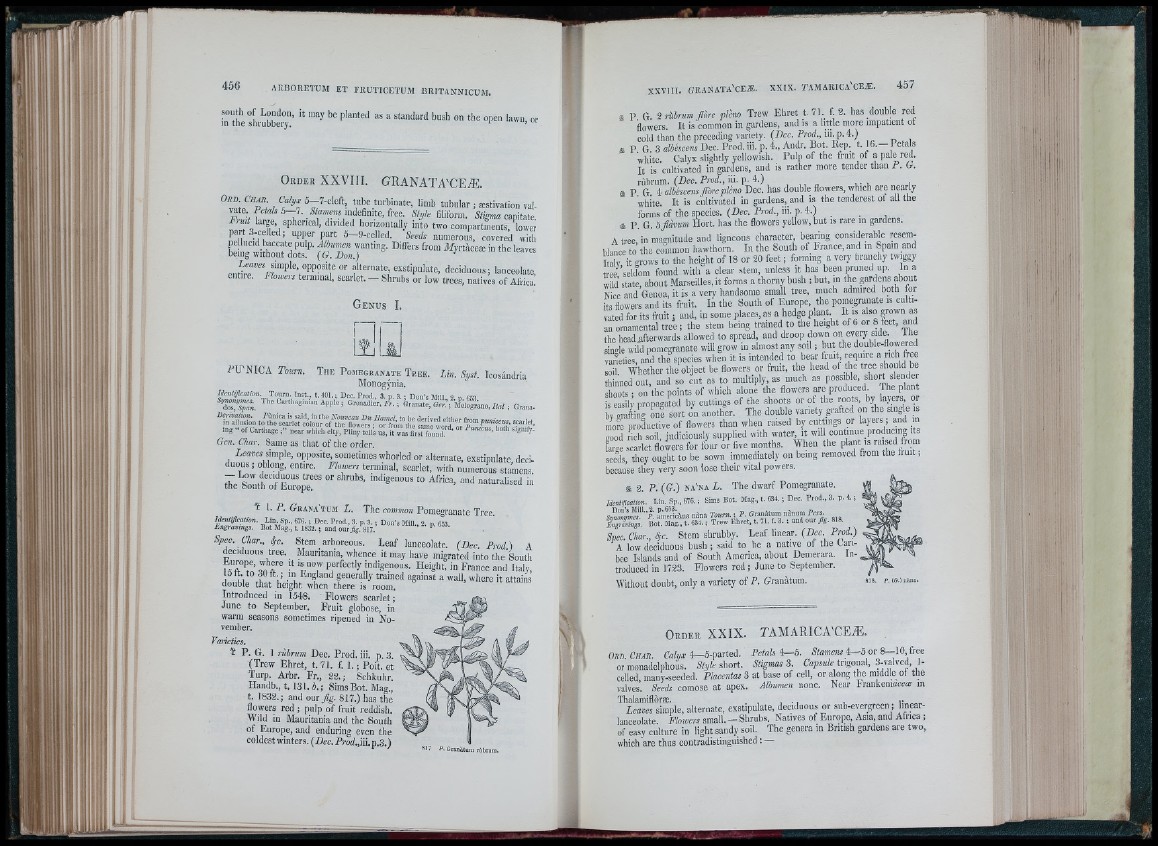
lül
to riie ffiiru b te i? ’ " " “‘“" ‘'“fo ““fo ° " fo® °P®" «wn, or
O r d e r XXVIII. GRANATA'CEÆ.
limb tubular ; æstivation val-
rate. irfaJs 5— /. Style filiform. capitate.
R t a latge spherical, divided horizontally into two compartment,s, lower
pa t 3-celled; upper part 5 -9-ce lled. Seeds numerous, covered with
dl^'wittSloTsl"-
■/«‘■""»'»‘■stipulate, deciduous; lanceolate,
eiitii e. Flotocrs terminal, scarlet. — Shrubs or low trees, natives of Africa!
G e n u s I.
P U 'NICA Tourn. T h e P o m e g r a n a t e T r e e . Lin. Syst. Icosândria
Monogynia.
Gen. Char. Same as that of the order.
opposite, sometimes whorled or alternate, exstipulate, deciduous
, oblong, entire. Flowers terminal, scarlet, with numerous stamens
t i e s T u t i / f ?uTo?!®'
The common Pomegranate Tree.
. p. 653.
1. P. G r a n a ' t u m L.
Identification. Lin. Sp., 676. ; Dec, Prod., 3. p. 3. : Don’s Mill 5
Engravings. Bot Mag., t. 1832. ; and our Jig. 817. ’
Spec. Char., f r . Stem arboreous. Leaf lanceolate. (Dec. Prod( A
deciduous tree. Mauritania, whence it may have migrated into the South
I t ? ’ on e f Pf'®o%,i“ fogO“oiis. Height, in France and Italy,
t f a t ' ? e 4 h ? : l ? " £ : t t e ^
Introduced in 1548. ' Flowers scarlet ;
June to September. Fruit globose, in
warm seasons sometimes ripened in November,
r arieUes.
¥ P. G. I ribrmn Dec, Prod. iii. p. 3.
(Trew Ehret, t. 71. f. 1. ; Poit. et
Turp. Arbr. Fr., 22.; Schkuhr.
Handb., t. 131. 5.; Sims Bot. Mag.,
t. 1832.; and oury%. 817.) has the
flowers red ; pulp of fruit reddish.
Wild in Mauritania and the South
of Europe, and enduring even the
coldest winters. (Dec. Pro«.,iii. p.3. )
^ ' Si 7 P. Granàturn rùbrum.
m P G. 2rhbrum fibre pièno Trew Ehret t. 71. f.2 . has double red
flowers. I t is common in gardens, and is a little more impatient ot
cold than the preceding variety. (Dec. Prod., iii. p. 4.)
tt P G 3 aJiéscCTis Dec. Prod. lit. p. 4., Andr. Bot. Rep. t. 16. Petals
’white. Calyx slightly yellowish. Pulp of the fruit of a pale reft
I t is cultivated in gardens, and is rather more tender than P . G.
rùbrum. (Dec. Prod., iii. p- 4.)
tt P G 4 albescens JToreplèrw Dec. has double flowers, which are nearly
white. It is cultivated in gardens, and is the tenderest of all the
forms of the species. (Dec. Prod., in. p. 4.) _ ^
Si P. G. 5fiavum Hort. has the flowers yellow, but is rare in gardens.
A tree in magnitude and ligneous character, bearing considerable resemblance
to’ the common hawthorn. In the South of France, and in Spam and
I alv it grows to the height of 18 or 20 feet ; forming a very branchy twiggy
t ee seldom found with a clear stem, unless it has been pruned up. In a
wild state, about Marseilles, it forms a thorny bush ; hut. in the gardens about
Nice and Genoa, it is a very handsome small tree, much admired both for
its flowers and its fruit. In the South of Europe, the pomegranate is cultivated
for its fruit i and, in some places, as a hedge p k nt. I t is also g ow n as
an ornamental tree ; the stem being trained to the height of 6 or 8 feet, and
the head afterwards allowed to spread, and droop down on every side. The
single wild pomegranate will grow in almost any soil ; but the double-flowered
varfeties and the species when it is intended to bear fruit, require a rich free
soil. Whether the object be flowers or fruit, the head of the tree should be
thinned out, and so cut as to multiply, as much as possible, short slendei
shoots • on the points of which alone the flowers are produced. The plant
s ? Z p a ta te d by cuttings of the shoots or of the roots, by layers or
by gi3in7o"?e sort Jn anoth/r. The double variety grafted on the sing e is
I S productive of flowers than when raised by cuttings or layers ; and in
HOod rich soil iudiciously supplied with water, it will continue pioducing its
r « e snaldet floiers for four ¿Í five months. When the plant is raised from
seeds, they ought to be sown immediately on being removed from the fiu it,
because they very soon lose their vital powers.
tt 2. P. (G .) n a ' n a L. The dwarf Pomegranate,
IdsnliflcMwn. Lin. Sp., 676. ; Sims Bot. Mag., t. 634.; Dec. Trod.. 3. p. 4. ;
s:s.
Spec Char., f r . Stem shrubby. Leaf linear. (Dee. Prod.)
A low deciduous bush ; said to be a native of the Lan-
bee Islands and of South America, about Demerara. Introduced
in 1723. Flowers re d ; June to September.
Without doubt, only a variety of P. Granatum.
O r d e r XXIX. TAMARICA'CEA).
Oed. Chae. Calyx 4—5-parted. Petals 4- 5. Sim»«« 4 - 5 or 8 --1 0 free
or monadelphous. Niy» short. Stigmas 3 trigonal, 3-valved 1-
celled many-seeded. Placentas 3 at baae o( cell, or along the middle ol the
valves. Seeds comose at apex. Albumen none. Near I'rankeniaccrB in
Thalamifldrae. , . , ,
Leaves simple, alternate, exstipulate, deciduous or sub-etegreen ; linear-
lanceolate. Flowers small. — Shrubs. Natives of Europe Asia, and Atrica ;
of easy culture in light sandy_ soil. The genera in British gardens are two,
which are thus contradistinguished :
i I